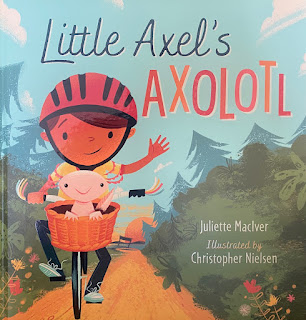I hope you enjoy my reviews of four new picture books for children aged 3-6 and five Junior novels for readers aged 8-12. A great collection!
1. Little Axel's Axolotl' by Juliette MacIver and illustrated by Christopher Nielsen
This is a very funny and endearing picture book, about a very special pet axolotl; named "Harris Aristotle" by his owner Axel. This is a very spoilt pet!Axel attends to his every wish and
want and need and feeds him with the finest cheese, and warms him with
the warmest of hats. Axel's fishy feet never touch the ground ... But
despite his life of ease, Harris has a secret dream ... and hatches a
secret, and daring scheme. Harris is about to surprise everyone!
Axel takes Harris everywhere with him, but Harris Aristotle craves the chance to bask in the sun and learn how to swim. He sets out one night on a brave (or is it foolish) adventure?
This wonderful little picture book will be released in July and will be a great hit with children aged 3-6. It has a surprising ending for this adventurous Axolotl.
2. 'The Wobbly Bike' by Darren McCallum & illustrated by Craig Smith
This is another special book from Walker Books to be released in July. Librarians should advance order!
3. 'Florence & Fox - The Pet Mouse' Zanni Louise & illustrated by Anna Pignataro
This is a beautifully illustrated picture book which will work well as a read aloud for children 2-5 or a self-read for 5-6 year olds. The central characters are Florence the crocodile and her friend Fox. Illustrator Anna Pignataro has created wonderful images for these sweet characters who are best friends. But they are VERY competitive. Each tries to trick the other by issuing challenges that they think they can win.
My only quibble with the book is
that the text is a little confusing in places. There a few gaps in the
dialogue that create disjunctions for the reader particularly on the
first 5 pages.
This delightful story with beautiful crayon and water colour illustrations will amuse and encourage your children's understanding of what true friendship looks like.
4. 'Mitchell Itches: An Eczema Story', by Kristen Kelly & Illustrated by Amelina Jones
5. 'Ducky The Spy - Expect the Unexpected' Written and Illustrated by Sean E. Avery
Just released! This funny little story about a duck who is also a spy, will amuse readers aged 7-10.
Laugh-out-loud who-dunnit ridiculousness in this new graphic novel from Sean E Avery
A
thief on the farm. A goat kidnapped by a gang of cats. A giant chicken.
Ducky the Spy and Donny “The Distraction” Donkey are on the case.
7. 'Stitch' by Padraig Kenny and illustrated by Steve McCarthy
Pádraig Kenny is an Irish writer who hails from Newbridge in County Kildare. His
debut novel 'Tin' was published in 2018 and was Waterstones Children’s
Book of the Month. It has been nominated for the CILIP Carnegie Medal
and several other awards. Since then he has had success with his second novel 'Pog' (2019). And his third novel 'The Monsters of Rookhaven' (2020), received the 'Honour Award for Fiction in the 2021 KPMG
Irish Children's Books Ireland awards. It was also nominated for the Carnegie
Medal. This fifth novel "Stitch" was published by Walker Books in 2024. It was
'Times Children's Book of the Month' in January 2024.

8. 'Knights and Bikes - Wheels of Legend' by Gabrielle Kent and illustrated by Rex Crowle & Luke Newell
Welcome to the sleepy island of Penfurzy, where nothing exciting ever really happens. OR DOES IT? Adventure awaits Demelza and her new best friend in the whole world, Nessa, as they explore the island and uncover the mysteries of the Penfurzy Knights. With a honking pet goose sidekick, quirky islanders and a legendary treasure to find, it's up to Nessa and Demelza to ride their bikes, solve the puzzles before them, and face down danger with frisbees, water-balloons, feathers .... and a toilet plunger. THEIR FRIENDSHIP WILL WARM YOUR HEART. THEIR BRAVERY WILL MAKE THEM LEGENDS.This is is a mystery with a sprinkling of wonderful black and white images by Rex Crowle & Luke Newell. Readers aged 10-13 will enjoy the engaging story
9. 'Queen of Dogs' by Joe Weatherstone & illustrated by Nicolette Treanor
Maddy’s family is talented and ambitious — sporting trophies, top grades, they collect them all. But Maddy would rather spend time with her best friend, her pug Gusto. When Gusto disappears … her world changes.
Her search for Gusto reveals a surprising talent and Maddy can't believe her ears. She can understand everything the neighbourhood dogs are saying and suddenly Maddy becomes the go-to canine problem solver. But when more and more dogs go missing, Maddy finds herself with a much bigger problem … and she is going to need a lot of friends – two-legged and four-legged – to help her solve it ...
This is a debut novel from Joe Weatherstone that speaks of loneliness and how friends and animals can help to overcome these challenges. It is Joe's debut middle grade novel, that 12-13 year-olds will enjoy and find relatable. Joe is actually Creative Producer and her work includes the 'Emmy' winning children's series 'Hardball', 'Oscar' nominated 'Inja' and the Logie winning 'Housos'. She lives in Sydney with her two children and two dogs!














